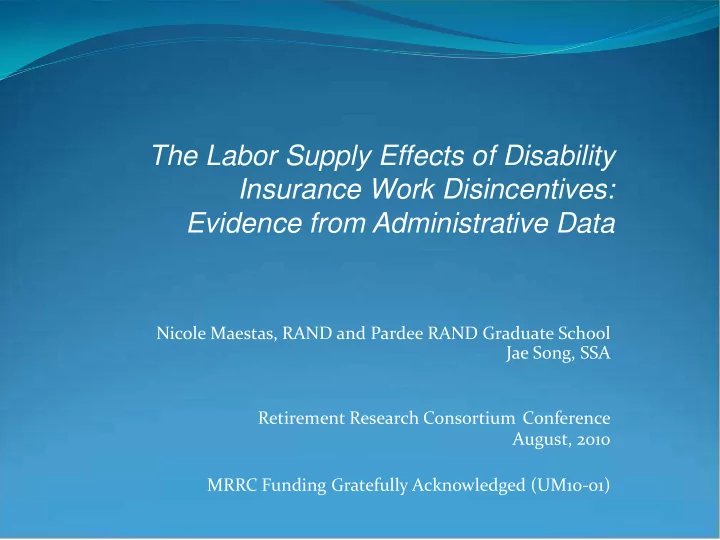

The Labor Supply Effects of Disability Insurance Work Disincentives: Evidence from Administrative Data Nicole Maestas, RAND and Pardee RAND Graduate School Jae Song, SSA Retirement Research Consortium Conference August, 2010 MRRC Funding Gratefully Acknowledged (UM10-01)
Introduction The causal effect of DI on labor force participation is hard to estimate because all face same benefit schedule Bound (1989) used rejected applicants to establish upper bound for 1970’s Chen and van der Klauuw (2008) use age-based discontinuities in eligibility formulas to establish upper bound for 1990’s We use a little-studied interaction between DI and OA: DI benefits payable until FRA, at which point they automatically convert to OA benefits No change in benefit amount, but SSA earnings test applies instead of strict DI work rules Abrupt relaxation of implicit high marginal tax on earnings: 100,000% to 33% before 2000 100,000% to 0% after 2000 If work disincentives binding, then we should observe an increase in labor supply at FRA
SSDI Work Rules Waiting Period Earnings must be below Substantial Gainful Activity (SGA) threshold for 5 months prior to entitlement SGA threshold in 2010 is $1000/month Trial Work Period (TWP) Once entitled, beneficiaries can test ability to work Earnings unrestricted Once earnings exceed SGA for 12 months, benefits suspended for all subsequent months when earnings exceed SGA Implicit marginal tax on average beneficiary of 100,000% Extended Period of Eligibility Benefits paid for months when earnings below SGA, for 3 years after TWP If earning above SGA at end of 3 years, benefits terminated Expedited reinstatement for 5 years
SSDI Budget Constraint Income SSDI Benefit Hours H SGA 0
Budget Constraint at Conversion Income SSDI Benefit Hours H SGA 0
Budget Constraint at Conversion Income SSDI Benefit Hours H SGA 0
SSDI Caseload by Diagnostic Group 2,500,000 Musculoskeletal Circulatory 2,000,000 Mental Disorders Nervous+Sense Unknown 1,500,000 Respiratory Endocrine 1,000,000 Injuries Neoplasms 500,000 Mental Retardation Digestive Genito-Urinary - 1995 1996 1997 1998 1999 2000 2001 2002 2003 2004 2005 2006 2007 2008 Infect+Parasitic
SSA Administrative Data All Primary Worker SSDI beneficiaries in 1995-2008 Born 1934 to 1943 In current pay status at the end of each year Sample identified from Disabled Beneficiaries and Dependents (DBAD) MBR Extracts Matched to Master Earnings File, 831 File, Master Beneficiary Record
Number of DI Beneficiaries in Birth Cohort by Age 400,000 350,000 1934 300,000 1935 1936 250,000 1937 1938 200,000 1939 1940 150,000 1941 1942 100,000 1943 50,000 - 60 61 62 63 64 65 66 67 68 69 70 Age
Fraction of DI Beneficiaries with Annual Earnings > $6,000 0.07 0.06 1934 0.05 1935 1936 0.04 1937 1938 0.03 1939 1940 0.02 1941 0.01 0 60 61 62 63 64 65 66 67 68 69 70 Age
Mean Annual Earnings of DI Beneficiaries if Earnings > 0 14,000 12,000 1934 10,000 1935 1936 8,000 1937 1938 1939 6,000 1940 1941 4,000 1942 2,000 - 60 61 62 63 64 65 66 67 68 69 70 Age
Research Design Estimate change in labor supply as birth cohort reaches their FRA Regression discontinuity estimator Regress individual labor supply outcome on series of age dummies Coefficients of interest are for age 66 and age 67 Control for diagnostic group, year of birth, age at entitlement, sex, PIA, education Assumes other factors trend smoothly through FRA
Regression-Adjusted Earnings by Age (As Percent of Earnings at Age 60) 0 61 62 63 64 65 66 67 68 69 70 -10 -20 Percent of Age 60 Earnings -30 -40 All Worked at t-1 -50 -60 -70 -80 -90 Age
Regression-Adjusted Earnings by Age and Diagnostic Group (Relative to Age 64) Subsample with Recent Work Activity (Worked at t-1 ) 3000 Annual Earnings Relative to Age 64 2000 1000 Mental Disorders Musculoskeletal 0 Injuries 61 62 63 64 65 66 67 68 69 70 Nervous+Sense Neoplasms -1000 -2000 -3000 Age
Conclusion DI recipients respond to changes in work incentives Evidence of some untapped work capacity among even the oldest DI beneficiaries About 20-25% of caseload is ages 60-65 during 1992- 2006 Our results are likely a lower bound estimate of the work capacity of all DI beneficiaries
Extra Slides
Figure 3. Age Profile in Labor Force Participation by DI Status at Age 63-64 20.0 70.0 On DI at Ages 63-64 18.0 60.0 16.0 % Working if Not On DI at 63-64 Not On DI at Ages 63-64 % Working if On DI at 63-64 50.0 14.0 12.0 40.0 10.0 30.0 8.0 6.0 20.0 4.0 10.0 2.0 0.0 0.0 59-60 61-62 63-64 65-66 67-68 69-70 Age
Table 6. Adjusted DD Estimates of Effect of Relaxing DI Work Disincentive on Hours, Weeks, and Earnings ΔHours per ΔWeeks per ΔWorks ΔAnnual Δ(Earnings>= Week Year Full-Time Earnings SGA) 4.288** 5.093** 0.080** 3,005.699** 0.072** D j (0.414) (0.479) (0.008) (416.312) (0.009) ΔDemographics X X X X X ΔNet Worth and ΔIncome X X X X X ΔHealth Status X X X X X ΔHealth Insurance Coverage X X X X X Covariates Fully Interacted with Treatment X X X X X Multiple Pre-/Post Periods X X X X X Mean for DI Participants at 63-64 1.135 1.603 0.016 754.518 0.025 No. Obs 29083 28976 29611 29642 29642
Recommend
More recommend